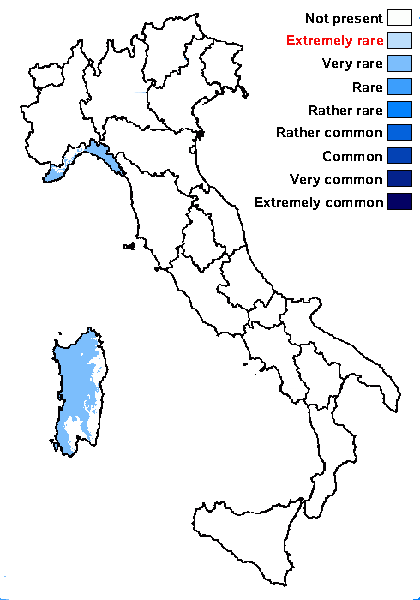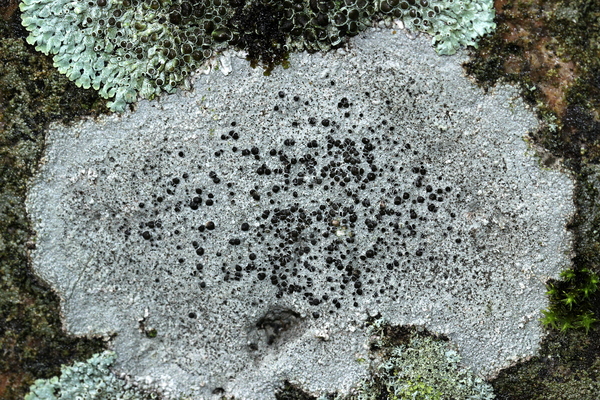Rinodina moziana (Nyl.) Zahlbr.
Cat. Lich. Univ., 7: 544, 1931. . Basionym: Lecanora moziana Nyl. - Lich. Japon.: 40, 1890.
Synonyms: Mischoblastia moziana (Nyl.) S.Y. Kondr., Lőkös & Hur; Mischoblastia vezdae (H. Mayrhofer) S.Y. Kondr., Lőkös & Hur; Rinodina atrocinerea var. nigrocaerulescens (Wedd.) H. Olivier; Rinodina confragosa var. nigrocaerulescens (Wedd.) Boistel; Rinodina destituta (Nyl.) Zahlbr.; Rinodina vezdae H. Mayrhofer
Distribution: N - Lig. C - Sar.
Description: Thallus crustose, episubstratic, rather thick, rimose-areolate or areolate, pale yellowish grey to rarely dark grey, the areoles up to 0.3-0.6 mm wide, flat, with a slightly verrucose surface. Apothecia at first lecanorine and more or less immersed in thallus, becoming pseudolecanorine and adnate, 0.4-1 mm across, with a black, usually flat disc, an entire, finally often excluded thalline margin, and a dark brown to black, persistent proper margin. Thalline exciple corticate, becoming partly or completely carbonized; proper exciple colourless or more often blue-green to black-brown in upper and outer parts, the pigmented parts reacting K+ red and N+ reddish; epithecium reddish brown, with a finely granulose epipsamma; hymenium colourless, 100-115 µm high; paraphyses 1.5-2 µm wide at mid-level, the apical cells 3-5 µm wide, with a brown cap; hypothecium colourless, up to 200 µm high. Asci 8-spored, clavate, the K/I+ blue tholus penetrated by a faintly amyloid apical cushion with parallel or diverging flanks, the wall K/I-, surrounded by a K/I+ blue outer layer, Lecanora-type. Ascospores 1-septate, brown, broadly ellipsoid, (21-)24-27(-30) x (10-)12-14(-16) μm, Mischoblastia-type, often swollen at septum at maturity, the torus poorly developed and the walls lightly pigmented, with an ontogeny of type A (apical wall thickening after septum formation). Pycnidia immersed. Conidia bacilliform, 3-5 µm x c. 1 μm. Photobiont chlorococcoid. Spot tests: thallus K+ yellow, C-, KC-, P+ faintly yellow. Chemistry: cortex with atranorin.Note: a species known from North America, Asia, Central Europe, the Mediterranean Region, Morocco and the Canary Islands, found on basic siliceous rocks, such as magmatite; closely related to R. oxydata. For further details see Sheard (2010).
Growth form: Crustose
Substrata: rocks
Photobiont: green algae other than Trentepohlia
Reproductive strategy: mainly sexual
Commonnes-rarity: (info)
Alpine belt: absent
Subalpine belt: absent
Oromediterranean belt: absent
Montane belt: very rare
Submediterranean belt: absent
Padanian area: absent
Humid submediterranean belt: very rare
Humid mediterranean belt: very rare
Dry mediterranean belt: absent

Predictive model
Growth form: Crustose
Substrata: rocks
Photobiont: green algae other than Trentepohlia
Reproductive strategy: mainly sexual
Commonnes-rarity: (info)
Alpine belt: absent
Subalpine belt: absent
Oromediterranean belt: absent
Montane belt: very rare
Submediterranean belt: absent
Padanian area: absent
Humid submediterranean belt: very rare
Humid mediterranean belt: very rare
Dry mediterranean belt: absent

Predictive model
 Index Fungorum
Index Fungorum
 GBIF
GBIF


